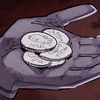
While each of the Nordic nations had its own currency pre-Rash, with only Finland using the Euro, it seems that the Icelandic crown (króna, plural krónur) has been adopted as the only currency of the Known World. We see coins being used, and there are strong hints that banknotes still exist as well.
Pre-Rash Currencies[]
| Nation | Currency name, sign, code | Divisional | Exchange Rate |
|---|---|---|---|
| Icelandic crown (króna, krónur), kr, ISK |
(historic: 1 kr = 100 aurar,
singular eyrir) |
1 EUR = 140 ISK | |
| Norwegian crown (krone, kroner), kr, NOK |
(historic: 1 kr = 100 øre) | 1 EUR = 9.25 NOK | |
| Swedish crown (krona, kronor), kr, SEK |
(historic: 1 kr = 100 öre) | 1 EUR = 9.30 SEK | |
| Euro, €, EUR | €1 = 100 c (or ct, for "cent"; note issues) |
(1 EUR = 1.08 USD = 0.70 GBP = 132 JPY) | |
| Danish crown (krone, kroner), kr., DKK |
1 kr = 100 øre (only coins of 50 øre are still in use) |
1 EUR = 7.46 DKK
(ERM II controlled) |
(Approximate exchange rates per 31-Dec-2015.)
Post-Rash Currency[]
Cash[]

Tuuri's coins

Current 100 ISK coin design
The first book's bonus comic shows Tuuri, freshly arrived from Finland, paying with coins in a bakery in Mora. Three of the five coins can be identified as current Icelandic coins, namely, two 100 kr and one 10 kr coin(s). Comments by the author further confirm that the post-Rash world uses a single instance of the traditional Nordic "crowns" for a currency, thus presumably the Icelandic one.

The continued existence of banknotes can merely be inferred from the fact that Torbjörn is shown imagining floating notes as he is told what the original book he was working on would cost. The design of those banknotes is thoroughly simplified, but does not seem to match that of current Icelandic ones. (They don't seem any more suggestive of the banknote designs currently used in the other four Nordic nations, either.)
Value[]
While it is tempting to look at the 200-400 ISK coins in Tuuris hand, compare them with the tartlet she bought, and conclude that the purchasing power of the Icelandic crown seems to be less than an order of magnitude different from what it is today, one should note that this result flies in the face of such pastry being pronounced a rare and expensive delicacy even in post-Rash Mora.
The fact that the Nordics are still using the same coin design 90 years after the apocalypse might indicate that they are in fact still using the same physical coins, due to some difficulty of producing new ones. In that case, it might be that the currency went through a normal-to-high inflation rate and the coins are used with the tacit agreement that a coin showing a token value of "100 kr" shall actually be worth, for example, a hundred thousand krónur. This would readily explain why banknotes, which are easier to produce than coins if one forgoes state-of-the-art security features, would not look like pre-Rash Icelandic ones; they would follow the historic example of Notgeld.
In any case, virtually no details on how the post-Rash currency fares in general - GDP, amount of cash in circulation, inflation and interest rates, other indicators of purchasing power, banking system, etc. etc. - are known yet.
